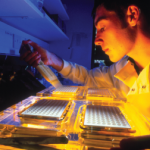Results: We observed associations between disease and variants in the major-histocompatibility-complex locus, in PTPN22, and in a SNP (rs3761847) on chromosome 9 for all samples tested, the latter with an odds ratio of 1.32 (95% confidence interval, 1.23 to 1.42; p=4×10-14). The SNP is in linkage disequilibrium with two genes relevant to chronic inflammation: TRAF1 (encoding tumor necrosis factor (TNF) receptor-associated factor 1) and C5 (encoding complement component 5).
Conclusions: A common genetic variant at the TRAF1-C5 locus on chromosome 9 is associated with an increased risk of anti–CCP-positive RA.
Commentary
The genetic susceptibility of autoimmune disorders, including RA and SLE, has proven to be complex. In RA, the contribution of the human leukocyte antigen (HLA) locus, HLA-DRB1, has been well recognized and supported by family studies.1 Other previously reported susceptibility loci for RA include variants of the Protein Tyrosine Phosphatase N22 (PTPN22), Cytotoxic T-Lymphocyte Antigen 4 (CTLA-4), and peptidyl arginine deiminase, type IV (PADI4).2-4 As the scale of genome wide studies expands, finer resolution studies will likely uncover further loci with more modest effects. Recently, two articles have unveiled additional single nuclear polymorphisms (SNP) that are associated with susceptibility in RA.
Plenge et al. reported the results of a genome-wide association study using an anti–CCP-positive population of RA patients. Using a multistage study design with multiple sample sets, the authors confirmed the association around the HLA-DRB1 and PTPN22 loci. In addition, this study newly identified a 100-kb region on chromosome 9, containing TRAF1 (encoding tumor necrosis factor associated factor 1) and C5 (encoding complement component 5). Although both TRAF1 and C5 were interesting candidate genes, a single causal allele was not identified.
A separate linkage peak conferring susceptibility to RA had been previously identified in the long arm of chromosome 2 (2q) in genome-wide studies.5 Building on this finding, Remmers et al. undertook a large case-control disease-association analysis of 13 selected candidate genes within this chromosome 2q linkage region. They confirmed a SNP in CTLA4, with a known association, but also revealed an association with an unlinked SNP in STAT4 (encoding signal transducer and activator of transcription 4).
Further fine mapping of the STAT1-STAT4 region demonstrated an association with four SNPs in the third intron of the STAT4 gene. There was no difference between the anti–CCP-positive and -negative subgroups, and the effect was not attributable to the CTLA4 association in the same region. This region had also been reported to have an association with SLE.6,7 The authors went on to genotype three series of SLE case control subjects with European ancestry. They found a strong association with the STAT4 variant in all three series.

